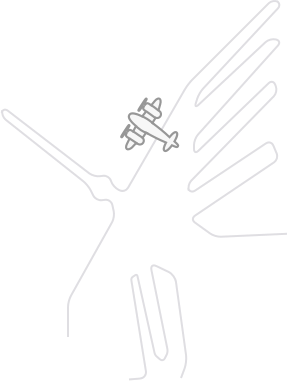A few weeks ago I had the privilege of visiting Chachapoyas for the first time, a jewel in the heart of Peru's northern jungle. When the opportunity came up to be part of a FamTrip (familiarization trip) to this destination, I did not hesitate to accept. At first, I wondered if Chachapoyas was the capital of the San Martin or Amazonas regions, both of which are located in the lush Peruvian north. The answer, I discovered, was Amazonas. I knew two things about this place: that it was the starting point for exploring the majestic ruins of Kuelap and the breathtaking Gocta Waterfall, and that I couldn't wait to get there and immerse myself in its magic, even if it was just for a weekend. The excitement of discovering a new destination that I had only seen in photos or heard about in stories was palpable. I was ready to fill my soul and recharge batteries with a dose of adventure and mystery.

Travel team
Day 1: Getting to know the city
We met up with the rest of the group at the Lima airport in the afternoon, which was the ideal prelude to getting to know each other and then catching the direct Atsa Airlines flight that took just over an hour to Chachapoyas. I was worried about landing at night and missing the opportunity to see the entrance to the city from above and get a first impression of its streets in daylight. But the surprises began immediately. We landed just before sunset, with a beautiful golden light illuminating everything. From the air, you can see that everything is green, absolutely everything. When I got off the plane, I experienced a familiar feeling that many of us might have when we visit cities that are not capitals or do not have the omnipresence of modernity: everything becomes more beautiful, more innocent, more genuine.

Chachapoyas view
On the way to the hotel, a 10-minute drive from the plaza in the middle of the countryside, it was getting dark and cold. Chachapoyas is characterized by its unique ability to combine two regional universes: a densely forested jungle, rich in wildlife and biodiversity, and a rugged highland where the nights are cold and the dry, icy air of the Andes provides a sense of purity to breathe.
After arriving at the hotel, settling in, and getting some rest, we went out to see the center of the city. Chachapoyas is very pretty, cozy, and well organized. The center, which includes the main square and its surroundings, is reminiscent of Cusco with its colonial houses and cobblestone streets. A curiosity of this city is that it was the first in Peru to prohibit the circulation of motorcycle taxis, which makes it more orderly and less chaotic than other cities in the interior.

Downtown
We walked through the center, visiting plazas, churches and streets. It's a safe place to walk, and not for nothing it is considered one of the safest cities in the country, if not the safest.
That night, we dined at a downtown restaurant called ‘El Batán del Tayta’, which is known for fusing its dishes and drinks with local ingredients such as bananas and cecina (pork), as well as tropical fruits and edible insects on the drink menu. It was a great way to start the trip.
Before returning to the hotel, we visited the Main Square, beautifully illuminated with warm light and surrounded by local shops, with the Cathedral standing out. The excellent impression I got of Chachapoyas on this first day only increased my enthusiasm to explore more. After a well-deserved night's rest at the hotel, I was ready for what lay ahead.
Day 2: The Domains of an Ancient Civilization
I woke up after a quiet night, without noise and surrounded by nature. I was the first to arrive for breakfast, very excited and eager to make the most of the day. Today it was time to visit the Kuelap fortress, an impressive pre-Inca construction located in the province of Luya, about 3,000 m.a.s.l. and about an hour and a half from the city.

Kuelap fortress
Kuelap is the main monument of the Chachapoyas culture, dating back to 500 A.D. Our transportation left us at the checkpoint to board the cable car, the most direct and fastest way to get there due to its location on top of an imposing rocky mountain. This cable car left me impressed; it has nothing to envy to others in the world. What makes it even more special is the incredible view it offers: we pass between two large mountains, observing ancestral tombs embedded in the hills and a meandering river that can be seen in the distance from the heights. It is simply breathtaking, not only for the natural beauty of the landscape, but also for the unique vegetation, protected by the regional government, with such particular species of flowers and plants.
After a 20 minute ride in the cable car, we begin a 40 minute hike uphill. I recommend to wear light, comfortable clothes, pants, because at a higher altitude than Chachapoyas, you can feel cold in the shadows, and to always drink plenty of water. We enjoyed the nature, the environment, the fresh air and the interesting explanations of the guide, who told us about the place where we were, about the Chachapoyas culture, our location and what we would see. Upon arrival, we were greeted by an impressive stone wall, which made us understand why they call this place a fortress, as it surrounds and protects the entire enclosure, designed in ancient times to guard against enemies and protect the community.

Cable car
Once inside, we were in awe from every angle. The imposing walls, more than 20 meters high, highlight the skill and ingenuity of the inhabitants of the Chachapoyas culture to build on such high and inaccessible terrain. Our eyes were immediately drawn to the circular stone structures, more than 400 of which have been identified so far, that served as dwellings, among other uses. This shows that Kuelap was not just a fortress, but an entire community, almost a small city. In addition, there are spectacular views of the Utcubamba Valley from many points on the site.
After more than an hour of walking, we made our way back to take the cable car back to town. As I reflected on all that I had experienced and learned, a mixture of emotions came over me.
I felt a deep connection to history; walking among the remains of the fortress inevitably transports you to another era, imagining what life was like more than a thousand years ago.
I also experienced a deep serenity that led me to reflection. The altitude and isolation of Kuelap create a calm and serene atmosphere, while the majesty of the natural landscape invites you to contemplate how small we are, surrounded by a lush cloud forest and towering mountains.

Tacacho with cecina
At the end of the tour, don't miss ordering a fried corn tortilla with sweet potato, a refreshing trout ceviche, or the classic Peruvian corn with cheese. I returned to the city happy, full of new knowledge and reflections, and more ready than ever to face the next day's biggest challenge: the famous Gocta waterfall.
Day 3: The Force of Nature
Finally, the day I had been waiting for the most of the trip arrived. We got up very early to leave for the town where we would leave our vehicle to begin the hike. Cocachimba is a charming village in the jungle, picturesque and cozy. Its central square is an extensive garden without a trace of concrete, all green and remarkably tidy. There is no trace of chaos, quite the contrary; it is a serene place that invites to rest and, at the same time, to look for new adventures.

Cocachimba
We used a store that also serves as a restaurant to prepare ourselves, buy water and provisions. In my case, I took the opportunity to change my long pants for shorts, knowing that the hike ahead of us would be long and hot, entering a jungle climate. After registering our attendance and committing to bring back all the plastic we had, we began the hike. It is a challenging route, due to the ups and downs of the trail. However, it is well marked and does not have a significant altitude, which helps maintain endurance due to the higher oxygen content in the air.
The road to the waterfall is incredible. You have to experience it to fully appreciate it. Walking in the jungle, surrounded by so much nature, provides a unique and beautiful sensation. You feel part of the ecosystem, aware of entering a foreign land that deserves to be cared for and respected in order to live the best possible experience.
The connection with nature in these places is so deep that it makes you feel more connected to the natural environment and more aware of the beauty and fragility of the environment.

Hike to Gocta waterfall
During the three-hour hike, there are points to stop, take pictures, take a deep breath and recharge your energy. Along the way, different aromas of plants, trees and vegetation in general are perceived, in addition to the aroma of coffee, since this place has an ideal climate for its cultivation. You can also hear the varied sounds of the environment, such as the songs of birds, the constant chorus of insects, the silence itself and, of course, the imposing roar of the water as it falls from the waterfall.
The closer you get, the more intensely you hear the roar of the water falling from more than 700 meters high, and emotions rise with the expectation of witnessing something spectacular. I decided to prepare myself for the moment, so I walked alone for the last 20 minutes, put on my headphones and chose a playlist according to the moment. When I spotted the main viewpoint, I turned off the music and gave myself completely to what I was about to witness. As I got closer, the sound of the water intensified, adding a dramatic touch to the scene. I left behind the lush tunnel of plants and trees to reach an open space and finally contemplate the reason for so much effort: the impressive Gocta waterfall. I was speechless before such a marvel. A few tears of joy came to my eyes as I stood in that place, in that moment, and even now, remembering it, I feel a deep nostalgia, because there are few moments in life when one feels so blessed.

Gocta waterfall
After contemplating for quite a while and capturing photos and videos, I felt a deep desire to give thanks for the experience. I remembered something that a friend taught me years ago in a special place in the Sacred Valley in Cusco, at a precise moment. I made a small offering to the earth in my own way, using a Kintu, a bouquet of three coca leaves that is offered to Pachamama (Mother Earth) in gratitude for everything received, asking permission to enter her domain and requesting her protection, aware of how insignificant one feels before the greatness of nature.
Having reflected for a moment on my feelings, I decided to descend further to get as close as possible. Without thinking too much and taking advantage of the favorable conditions, I put on my swimsuit and water shoes to get in. Although it was very cold, about 8 degrees Celsius, with the wind it felt even colder, almost like 0 degrees. Still, I made it. Although the waterfall was not even at 40% of its power, it was still strong enough to feel its impact.

Dip in the waterfall
The guides who accompanied us told us that when the waterfall is at its peak, the roar can be heard an hour before and it is impossible to get as close as we did. I stayed in the water, cold but feeling clean and refreshed, absorbing all the energy of bathing in some of the purest water I have ever been in. My advice to those who wish to do the same is to fully submerge, as the wind can increase the feeling of cold and make it difficult to stay in the water for long. While I was in the water I could only hear the sound of the waterfall and in the distance voices cheering me on and calling my name.
I spent about 10 minutes in the water, renewing myself and filling up with energy, until it was time to get out, dry off, change, and take one last look at the impressive waterfall and the beautiful scenery surrounding it. I then made my way back, knowing that it would be more challenging because of the climb. But it was worth the effort. The return to Cocachimba turned out to be more challenging than I had heard, but I really enjoyed it. Factors such as talking more with the guide and learning about different species of rare butterflies along the way, drinking two glasses of guarapo (sugar cane macerate) to regain energy, and continuing to reflect on all that I had just experienced, helped make it more bearable. In addition, the lunch that awaited us before returning to Chachapoyas was a great motivation.

Rare butterfly species
After handing over the plastics I was carrying, I sincerely thanked the lady at the checkpoint for the wonderful experience.
I especially appreciated the pleasant surprise of finding the road to Gocta so clean and well maintained, something that deserves to be highlighted in these times when empathy and respect for the environment are often in short supply.
Day 4: See you soon
The flight left at 11 a.m., and although there was no time for a last stroll through the center, I take with me the best memory of Chachapoyas. This city, which blends the essence of the jungle and the highlands with its contrasts of cold and heat, captivated me with its cleanliness, order and, above all, the warmth of its people. Discovering Chachapoyas was a pleasant surprise; a destination I knew little about, but which captivated me with its unique charm. There are still stories to live and places to discover in this magical land. The city left me with the firm intention of returning and continuing to discover all that it has to offer. Chachapoyas is without a doubt a place I will always want to return to, with the promise of new adventures patiently awaiting.

Gocta


